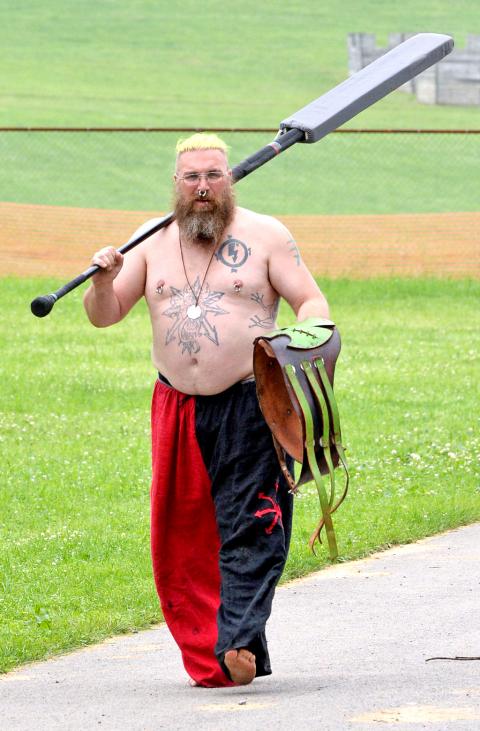On a warm summer’s day in the tranquil Pennsylvania countryside, elves battle crusaders, hobbits clash with knights and archers target samurai swordsmen. And everyone lives to tell the tale.
Originally inspired by fans of J.R.R. Tolkien’s The Lord of the Rings, the week-long Ragnarok sees fantasy enthusiasts donning period costumes, sliding into character and playing out medieval battles by whacking each other with padded clubs or swords.
“This event is all about fighting,” declares “General Graymael” to the legion of merry combatants who gathered late last month for the 29th edition of Ragnarok in Slippery Rock, a small town north of Pittsburgh.

Photo: AFP
“Your objective is to have more fun and get in more fighting that the person on either side of you,” Graymael — who by day is 51-year-old senior civil servant David Vierling — told the gladiators. “If you do that, you have won.”
Ragnarok — which takes its name from the apocalypse of Nordic mythology — brings together enthusiasts from across the US who revel in heroic fantasy literature, role-playing or just plain history, event coordinator Matthew “Will Scarlit” Tkach told AFP.
This year, some 1,400 warriors made the trek to Slippery Rock to pitch tents and gather around open fires on what is usually a vast wooded campground.
For seven days, they engaged in “dagorhir,” a contest-cum-sport with established rules, medieval-style outfits and non-lethal weapons made with polystyrene foam.
The eccentric jamboree dates back to 1977 when it was invented by a group of friends in the Mid-Atlantic state of Maryland, all fans of The Lord of the Rings.
‘A REAL PASSION’
“I am myself from 898, near Uppsala,” located in modern-day Sweden, explained a Viking chieftain who, away from Ragnarok, is a 28-year-old online salesman named William Ritchie.
A Nordic history buff, Ritchie spends his free time re-creating historic moments and fabricating costumes with fellow members of their dagorhir group in Michigan.
“It’s a real passion,” he said. “Most people get caught up in living day to day. It’s a good release from the pressures of the mundane world.”
Enthusiasts like Ritchie adhere to local chapters that stage their own events in the run-up to Ragnarok.
“It’s great to see each other once a year,” said Kyle “Jarn” Nell, a 27-year-old bank employee from Florida who schedules his vacation time around Ragnarok.
Participants range from “people who are pumping gas or scooping ice cream to doctors and lawyers,” said Tkach, an Ohio police officer.
The encampment is divided into sections including a Celtic fortress and the Dominion of the Unconquered Sun.
It’s also a hive of activity.
“Triumphs and defeats, parades and parties, tournaments and pit fighting, belly dancers, song, friendship, bloody battles and more lead up to the final battle and celebration!” promises an event brochure.
Before the daily great battle, participants prepare their armor, shields, swords and other armaments — fashioned out of soft, safe material.
The weaponry isn’t supposed to hurt, but there’s no question it’s a very physical confrontation.
“This sport is akin to rugby in terms of how physically difficult it is,” said Vierling.
If your adversary hits you once on an arm or leg, you can no longer use that limb. And if you are hit twice, or hit in the torso, that’s instant death.
Cheating is out of the question. “The entire game runs on honor,” explained Lyle “Sirius Trothari” Mahy. “Otherwise, the entire thing breaks down.”

Nov. 11 to Nov. 17 People may call Taipei a “living hell for pedestrians,” but back in the 1960s and 1970s, citizens were even discouraged from crossing major roads on foot. And there weren’t crosswalks or pedestrian signals at busy intersections. A 1978 editorial in the China Times (中國時報) reflected the government’s car-centric attitude: “Pedestrians too often risk their lives to compete with vehicles over road use instead of using an overpass. If they get hit by a car, who can they blame?” Taipei’s car traffic was growing exponentially during the 1960s, and along with it the frequency of accidents. The policy

Hourglass-shaped sex toys casually glide along a conveyor belt through an airy new store in Tokyo, the latest attempt by Japanese manufacturer Tenga to sell adult products without the shame that is often attached. At first glance it’s not even obvious that the sleek, colorful products on display are Japan’s favorite sex toys for men, but the store has drawn a stream of couples and tourists since opening this year. “Its openness surprised me,” said customer Masafumi Kawasaki, 45, “and made me a bit embarrassed that I’d had a ‘naughty’ image” of the company. I might have thought this was some kind

What first caught my eye when I entered the 921 Earthquake Museum was a yellow band running at an angle across the floor toward a pile of exposed soil. This marks the line where, in the early morning hours of Sept. 21, 1999, a massive magnitude 7.3 earthquake raised the earth over two meters along one side of the Chelungpu Fault (車籠埔斷層). The museum’s first gallery, named after this fault, takes visitors on a journey along its length, from the spot right in front of them, where the uplift is visible in the exposed soil, all the way to the farthest

The room glows vibrant pink, the floor flooded with hundreds of tiny pink marbles. As I approach the two chairs and a plush baroque sofa of matching fuchsia, what at first appears to be a scene of domestic bliss reveals itself to be anything but as gnarled metal nails and sharp spikes protrude from the cushions. An eerie cutout of a woman recoils into the armrest. This mixed-media installation captures generations of female anguish in Yun Suknam’s native South Korea, reflecting her observations and lived experience of the subjugated and serviceable housewife. The marbles are the mother’s sweat and tears,